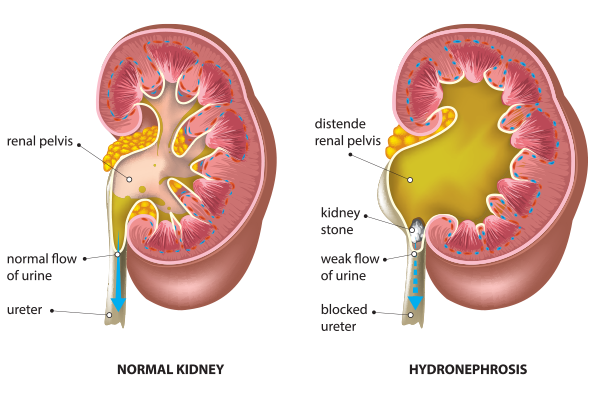
Hydronephrosis is a condition that affects the urinary tract, causing one or both kidneys to swell due to urine not fully emptying from the body. This can lead to various symptoms and, if left untreated, can result in serious complications. Understanding the causes, symptoms, and treatment options for hydronephrosis is crucial for managing this condition effectively.
Synopsis
What is Hydronephrosis?
Hydronephrosis occurs when there is a blockage or obstruction that prevents urine from flowing from the kidneys to the bladder. This can cause the kidneys to swell, leading to discomfort and potential damage. The condition can be unilateral (affecting one kidney) or bilateral (affecting both kidneys) and can range from mild to severe.

Causes of Hydronephrosis
There are several potential causes of hydronephrosis, including:
-
Kidney Stones: These hard deposits can block urine flow, leading to swelling.
-
Tumours: Growths in the bladder or prostate can obstruct urine flow.
-
Benign Prostatic Hyperplasia: Enlargement of the prostate gland can put pressure on the urethra.
-
Pregnancy: The expanding uterus can compress the ureters, causing urine to back up.
-
Congenital Blockages: Some individuals are born with structural abnormalities that impede urine flow.
Symptoms to Watch For :
The symptoms of hydronephrosis can vary depending on the severity and underlying cause. Common symptoms include:
-
Pain: Sudden or intense pain in the sides, abdomen, or back.
-
Nausea and Vomiting: Often accompanying the pain.
-
Painful Urination: Discomfort or burning sensation while urinating.
-
Blood in Urine: Visible blood or pinkish urine.
-
Urinary Tract Infections (UTIs): Frequent infections can indicate hydronephrosis.
-
Inability to Empty Bladder: Feeling like you can't empty your bladder.
Diagnosis of Hydronephrosis

Diagnosing hydronephrosis typically involves a combination of medical history, physical examination, and diagnostic tests. These may include:
-
Ultrasound: A non-invasive imaging test that can show swelling in the kidneys.
-
CT Scan: Provides detailed images of the urinary tract.
-
MRI: Offers a comprehensive view of the kidneys and surrounding structures.
-
Urine Tests: To check for infections or blood in the urine.
Treatment Options
Here's a table summarizing the treatment options for hydronephrosis:
|
Treatment Option |
Description |
When It's Used |
|
Medications |
Pain relievers and antibiotics to manage symptoms and treat infections. |
Used for pain management and treating infections. |
|
Surgical Interventions |
Procedures like stent placement or pyeloplasty to remove blockages and restore urine flow. |
Used when there is a physical obstruction causing hydronephrosis. |
|
Non-Surgical Treatments |
Catheterization or nephrostomy to drain urine from the kidneys. |
Used when immediate drainage of urine is needed. |
Managing Hydronephrosis at Home
In addition to medical treatments, there are several ways to manage hydronephrosis at home:
-
Dietary Changes: Stay hydrated and avoid foods that can cause kidney stones.
-
Lifestyle Modifications: Regular exercise and maintaining a healthy weight.
-
Monitoring Symptoms: Keeping track of symptoms and seeking medical help if they worsen.
Complications of Untreated Hydronephrosis
If left untreated, hydronephrosis can lead to serious complications, including:
-
Kidney Damage: Prolonged swelling can cause permanent damage to the kidneys.
-
Infections: Increased risk of UTIs and kidney infections.
-
Kidney Failure: Severe cases can result in kidney failure, requiring dialysis or a kidney transplant.
Preventing Hydronephrosis
While not all cases of hydronephrosis can be prevented, there are steps you can take to reduce your risk:
-
Maintain Urinary Tract Health: Drink plenty of water and practice good hygiene.
-
Regular Check-Ups: Routine medical check-ups can help detect issues early.
-
Manage Underlying Conditions: Treat conditions like kidney stones or prostate enlargement promptly.
Living with Hydronephrosis
Living with hydronephrosis can be challenging, but with the right support and management strategies, you can lead a healthy life:
-
Coping Strategies: Find ways to manage pain and discomfort, such as relaxation techniques and physical therapy.
-
Support Systems: Connect with support groups or counselling services for emotional support.
-
Impact on Daily Life: Learn how to adapt your daily activities to manage symptoms effectively.
Conclusion
Hydronephrosis is a condition that requires prompt attention and proper management to prevent serious complications. By understanding the causes, symptoms, and treatment options, you can take proactive steps to manage your health effectively.
If you're looking for expert advice and personalized care, consider visiting Manipal Hospital Kharadi. Their team of experienced healthcare professionals is dedicated to helping you achieve optimal health and well-being. Whether you need diagnostic tests, treatment options, or ongoing support, Manipal Hospital Kharadi is here to support you every step of the way.
Stay informed, stay proactive, and take care of your health!
FAQ's
Diagnosis typically involves a combination of medical history, physical examination, and diagnostic tests such as ultrasound, CT scan, MRI, and urine tests to check for infections or blood in the urine.
Treatment depends on the underlying cause and severity. Options include medications for pain and infections, surgical interventions like stent placement or pyeloplasty, and non-surgical treatments such as catheterization or nephrostomy.
Yes, managing hydronephrosis at home involves dietary changes, staying hydrated, regular exercise, and monitoring symptoms. It's important to follow medical advice and seek help if symptoms worsen.
Untreated hydronephrosis can lead to kidney damage, increased risk of infections, and potentially kidney failure, which may require dialysis or a kidney transplant.
Preventive measures include maintaining urinary tract health by drinking plenty of water, practising good hygiene, managing underlying conditions promptly, and having regular medical check-ups.





















 5 Min Read
5 Min Read




2.png)













